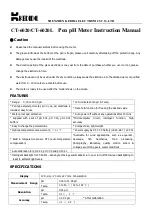
Measurements and Result Displays
R&S
®
FSPN
92
User Manual 1179.4363.02 ─ 01
Allan Variance / Allan Deviation
The "Allan Variance" and "Allan Deviation" result displays are tools to determine the
frequency stability of a DUT over a long period of time (days or even months).
Frequency stability is a measure of how well a DUT is able to produce its specified fre-
quency over time without deviating from that frequency. Because of the noise charac-
teristics of oscillators, standard variance or deviation are not really applicable. Instead
the Allan variance and deviation are the tools of choice for these statistical evaluations.
Like the standard deviation, the Allan variance and deviation show how much the fre-
quency of the DUT deviates from its specified (= average) value. Also like the standard
variance and deviation, the deviation is the square root of the variance.
The R&S
FSPN calculates the Allan variance from the phase noise spectrum using the
following relationship:
f
h
= integration bandwidth
S
y
= spectral density of fractional frequency fluctuations
τ
= observation time
f = offset frequency
Overall, low values, both variance and deviation, correspond to a stable DUT, high val-
ues to an unstable DUT.
When you measure the stability of an oscillator, the resulting curve has a characteristic
shape. The shape is the same for variance and deviation.
The point of interest in the diagram is the minimum of the curve. First, the deviation is
high, because of noise. During the progression of the observation, the noise averages
out until the minimum is reached. The minimum thus corresponds to the point in time
when the deviation from the specified frequency is at its lowest. After that, the stability
deteriorates due to temperature effects and aging.
From the slope of the curve, you can also identify the type of noise that is in effect
(white noise, flicker phase, white frequency, flicker frequency, random walk).
For a comprehensive discussion of the Allan variance, refer to application note
Time Domain Oscillator Stability Measurement - Allan Variance
The logarithmic x-axis corresponds to the observation time ("Tau"). Note that Tau is not
the measurement time, but the evaluated time - the measurement lasts longer than
Tau. Because the R&S
FSPN calculates the Allan variance based on the measurement
range of the phase noise measurement (offset frequency), the observation time corre-
sponds to the measurement range and vice versa.
The start time also defines the measurement bandwidth or integration bandwidth (f
h
in
the equation above):
Result Displays
















































